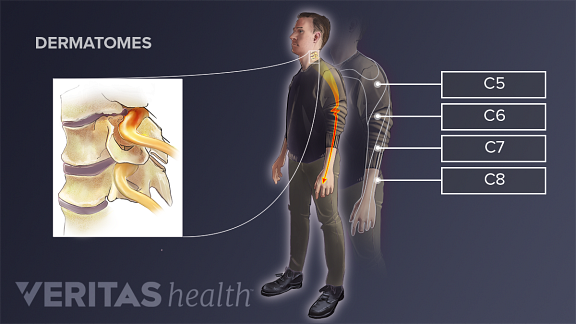Upper Back Pain Comeing Again After Monts
As you may already know through personal experience, back hurting can be uniquely complex and difficult to diagnose and treat. In that location are many types of dorsum pain, and a broad range of treatments that may or may not work for the aforementioned status.
Here we outline several insights that you may find helpful in your journey to finding and participating in a treatment arroyo that works for you.
A common cause of pain in the back is muscle strain. Lookout man: Lower Back Strain Video
Dorsum hurting is a complicated, personal experience
The intensity and manageability of pain are very different for every person. For example, i person with a herniated disc may experience excruciating hurting while another person with the same status has no symptoms at all. Similarly, a muscle strain tin can range from mild to debilitating.
See Hurting Generated by the Spinal Disc
With some weather, dorsum pain tin flare up and then subside, only to flare upwards again after a few weeks or months and gradually intensify over time. Because only you lot know your level of pain, your treatment volition nearly probable be more successful if you lot are an active participant in making decisions about your medical care.
Many structures in your back tin crusade hurting
Your back is subjected to various strong forces throughout the mean solar day, such every bit from twisting, sudden jolts, or poor posture when sitting hunched over. Any of your spine's many interconnected and overlapping structures are capable of condign injured and producing dorsum hurting. Mutual anatomical causes of back hurting include:
- Large muscles that support the spine
- Spinal nerves that go out the spinal canal and may go to the legs or elsewhere
- Facet joints that connect the vertebrae along the back of the spine
- Intervertebral discs that provide shock-absorption for the bones
For more information, see Spinal Anatomy and Back Hurting.
Basic, ligaments, tendons, and other anatomic structures are also capable of causing back pain.
See Causes of Lower Back Pain
The underlying crusade of pain may be hard to identify
It is usually difficult for the brain to distinguish between injury to 1 spinal structure versus another nearby. For example, a torn or herniated disc may feel like to an arthritic facet articulation due to their close proximity. In some cases, the same nervus root can be compressed or irritated by dissimilar structures, such as a disc or bone spur.
Meet Spinal Cord and Spinal Nervus Roots
Your physician volition take a thorough medical history, discuss your symptoms, and conduct a physical exam in club to accurately diagnose the cause of back pain. Sometimes diagnostic tests—such as 10-rays, MRI scans, or diagnostic injections—are needed when trying to locate or ostend the underlying cause of pain.
See Getting an Accurate Back Pain Diagnosis
Description of your pain is of import
Referred pain is pain felt in parts of the body other than the anatomical crusade.
How you lot depict your hurting, its expanse of distribution, and any related symptoms are important to determine a dorsum pain diagnosis. Three common classifications of dorsum pain include:
- Centric pain. Also chosen mechanical hurting, axial pain is confined to ane spot or region. Information technology may be described a number of ways, such as precipitous or dull, comes and goes, abiding, or throbbing. A musculus strain is a common cause of axial back pain as are facet joints and annular tears in discs.
See Axial Back Hurting: Most Common Low Dorsum Pain
- Referred pain. Often characterized as dull and achy, referred pain tends to move around and vary in intensity. As an instance in the lower dorsum, degenerative disc disease may crusade referred pain to the hips and posterior thighs.
See Depression Back Pain with Referred Pain
- Radicular pain. Usually described equally electric daze-like or searing, radicular pain follows the path of the spinal nerve equally it exits the spinal culvert. This type of pain is acquired by compression and/or inflammation to a spinal nervus root. In the lower back (lumbar spine), radicular hurting may travel into the leg. Other terms for radicular pain are sciatica or radiculopathy (when accompanied by weakness and/or numbness). It can be caused past conditions such as a herniated disc, spinal stenosis, or spondylolisthesis.
See Radiculopathy, Radiculitis and Radicular Pain
Once your doctor reaches an accurate diagnosis for your back pain, an effective handling plan can begin.

Radicular pain follows the path of the nerve into the arm or leg and may be accompanied by numbness or weakness.
Hurting is still real even if no anatomical reason is found
Fifty-fifty after many tests and doctor visits, in a small pct of patients the anatomical crusade for your back pain may remain elusive. If this is the case, the pain still needs to exist treated and there are a variety of nonsurgical care options that tin help alleviate or manage the pain.
Psychological factors, such as depression and sleeplessness, tin brand the hurting worse and besides need to be included every bit part of a comprehensive handling plan.
Meet Chronic Pain and Insomnia: Breaking the Cycle
For persistent dorsum pain and/or any neurological symptoms, it is always important to see a qualified spine specialist for a diagnosis. Ultimately, participating in the decision-making process about your medical care may help y'all have a improve outcome. Understanding your hurting is an of import element of this process.
Larn more:
When Back Pain May Exist a Medical Emergency
Preparing to Meet A Doctor for Back and Neck Hurting
Source: https://www.spine-health.com/blog/understanding-different-types-back-pain
0 Response to "Upper Back Pain Comeing Again After Monts"
Post a Comment